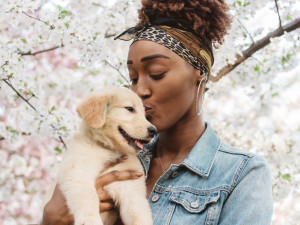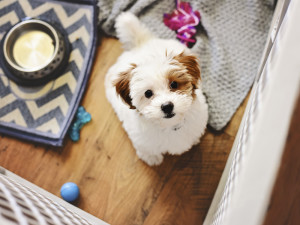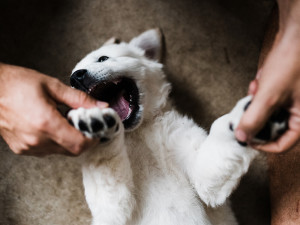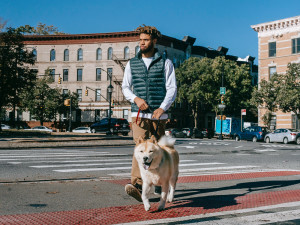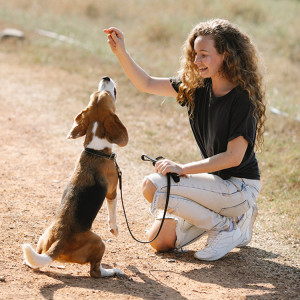How to Crate Train a Puppy at Night
It’ll make life easier for both of you – eventually
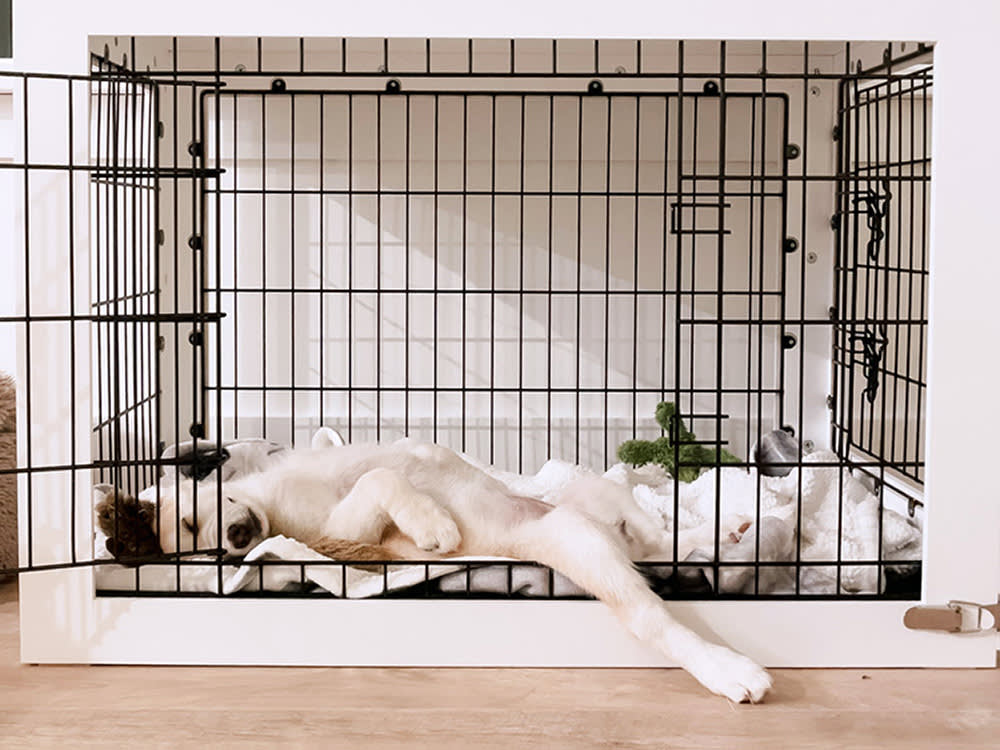
Share Article
In this article:
Why is night-time crate training important? How to crate train a puppy at night where should my puppy’s crate be at night? What if my puppy whines in the crate? How to handle night-time toilet breaks
If you’re a new puppy parent, the idea of putting your pup in a crate at night may seem a little cruel. Aren’t puppies made for cuddling? But in fact, crate training a puppy at night isn’t cruel at all – rather, it’s essential to their well-being. Getting them used to a crate may take some time and effort, though.
To get your puppy comfortable in their crate, start by introducing the crate in a positive manner. Place treats or toys inside to help your pup make a positive association with the space, and add a soft blanket or bedding. When it’s time for bed, place the puppy in the crate with a reassuring tone and a favourite toy. Avoid giving in to whining or barking; this may reinforce the unwanted behaviour. Make sure the crate is in a quiet, darkened room to encourage relaxation. Consistency is key; maintain a regular bedtime and bathroom schedule to help your puppy adjust.
Keep reading for more information, step-by-step instructions and answers to frequently asked questions about crate training.
Why is night-time crate training important?
When your puppy is brand-new and just learning to navigate their way around their new home, a crate helps prevent them from getting into mischief while you’re sleeping. “A crate can be a great option to help keep your puppy safe when you can’t watch them,” says Caroline Wilkinson, certified animal behaviourist and founder of Barket Placeopens in new tab.
She explains that a crate is meant to be a relaxing and calm space for your dog. “I like to use terms such as den, bedroom or rest zone when talking about a crate, as it gives us a much more positive idea of how this tool should be used. It should never be used as a form of punishment to shut your dog away.”
How to crate train a puppy at night
Ready to tackle crate-training with your new friend? Here’s how to get started.
Choose a crate
First things first: you’ll need to find a crate that’s the right size for your puppy. They should be able to stand up, turn around and lie down comfortably in the crate. Be sure to take into account how big they’re going to get – your pup may be tiny now, but you want the crate to last as they grow.
Crates come in many different styles, and while there’s nothing wrong with getting a hand-me-down crate from the local Gumtree group or buying a no-frills version that fits your budget, if you can afford to spend more, it may be worth it. “Consider investing in a fancy crate,” says trainer Ivan Petersel, founder of Dog Wizardryopens in new tab. He adds that if a wire crate is what is in your budget, that’s OK, but speak with a trainer and vet about which brands are safest, especially for young puppies.
Depending on the size of your home, you may want an extra crate (or two) as well. “Often, I will have more than one crate in the house,” says Ivan. “At least one of them is in a high-traffic area where the dog can see people coming and going.”
Make the crate comfortable
The crate is going to be your puppy’s bedroom, at least for a while, so do it up accordingly. “Fill the whole crate with comfortable bedding and avoid splitting the space into half sleeping/half toilet zone,” says Caroline.
You can give your pup meals in the crate, and they should also have access to water. “During the daytime (and overnight during hot weather), ensure there is always water available within the crate. A hook-on bowl is useful to stop your puppy sitting in it.”
Let your puppy get used to the crate
To start out, put the crate in a spot where you and your puppy hang out the most, whether that’s your living room, kitchen or bedroom. Having the crate in the middle of the action helps your dog associate it with good times. “Place the crate somewhere where your dog can feel a part of family life, but that isn’t too busy or noisy a space to relax in,” says Caroline.
Leave the crate door open so they can nose around and explore, and put some toys and a blanket in the crate, as well as food and water. “Give the best things in life inside the crate!” says Ivan. He recommends high-value treats, a frozen treat, or anything that’s safe for them.
Don’t close the crate door until your puppy is ready
Again, you want to make sure the crate feels like a safe and fun place to be – and that means taking it slowly when it comes to shutting the door. “Leave the door open and toss treats in to give your puppy the experience of running in and running out,” says Ivan. “Don’t let your dog think that the door closes every time they go in. When you do start closing the door, do it in increments. Gradually increase the amount of time the door is closed.”
How do you know when your puppy is ready for you to close the crate door? “Avoid shutting the door to the crate until your dog is comfortably going to the crate of their own accord,” says Caroline.
Create a puppy crate training schedule
People generally function better with routine, and that goes for dogs, too. Put your puppy in the crate for naps and at bedtime at consistent times, even if you’re home and available to keep an eye on them.
“When your puppy falls asleep naturally anywhere around your home, carefully lift them and place them in their crate so that they wake there feeling relaxed,” says Caroline. Before you know it, your puppy will be curling up in the crate all on their own.
Be strategic about crate time
When your puppy is ready to be left alone in a closed crate, keep a couple of things in mind. “Make sure the dog has plenty of exercise before going in the crate,” says Ivan. This helps encourage them to curl up and relax when they’re in the crate. Don’t put them in the crate just before you walk out the door, either, he says. “If you are leaving the house, crate the puppy 30 minutes before leaving. Many people crate their dog right before they leave. This creates a bad association.”
When you get home, don’t rush to let your puppy out, either (unless they’re desperate to go to the bathroom – you don’t want them to have an accident, obviously). “If you take the dog out right when you get home, the puppy is likely whining and clawing to get out,” says Ivan. “Don’t nurture anxiety by letting the dog learn that having meltdowns earns them freedom.” He suggests 30 minutes in the crate before you leave and after you get home, if possible.
Where should my puppy’s crate be at night?
At least at first, you can put your puppy’s crate near your bed so you can keep a close eye on them and be available if they need to go out to wee or poo. If you’d rather not have them sleeping in your room, you can put the crate right outside in the hallway. You can gradually move it further away once the puppy gets used to the crate and need to go out less often.
Should I cover my puppy’s crate at night?
Just like you pull your shades closed at night, many experts recommend covering the crate when your dog is sleeping, to foster good rest and keep from disturbing them. At bedtime, you can cover your puppy’s crate with a blanket to signal that it’s time for bed. Leave one side uncovered so you can keep an eye on your puppy. Or you can do this if they seem upset with the crate fully covered.
What should I do if my puppy whines in the crate?
Crate training a puppy at night will likely involve some amount of crying (the puppy, not you – though many a pet parent has shed some tears over the sound of their puppy whining). But should you let your puppy ‘cry it out’ in their crate?
Ivan says no. “When puppies whine, they are communicating something. It’s important to listen to your dog to understand what they’re saying. It may be boredom, excitement, anxiety, illness, a need to go to the toilet and more.”
What’s the best way to help a puppy stop whining?
Ivan encourages puppy parents to reframe their state of mind. “Instead of thinking ‘how do I stop the whining’, reflect on the root causes. Are all of your dog’s needs met? Have you given them enough exercise and made sure it wasn’t a pain or physical issue?”
He says that automatically opening the crate door when they cry isn’t the answer. “Don’t let them out while they are whining. This may lead them to think that whining is the way out.” Rewarding the moments when they’re not whining is key, as well. “Acknowledging calm states of mind is more important than focusing on whiny moments. Show the puppy that calmness is the key to your heart.”
How to handle night-time toilet breaks
Humans often have to get up to use the bathroom at night, and so do puppies. To reduce the need for night-time walks (especially when lead training is still a work in progress), keep the following tips in mind, says Ivan.
Always take your puppy out for a toilet break before they go into their crate (and remember, they should be heading into the crate 30 minutes before you leave, if you’re leaving).
Puppies can generally hold their bladder for one hour for every month of age. “For example, if they are two months old, they’ll need to come out before two hours. If they are three months old, they can only be in a crate for three hours max.”
Make the crate as accident-proof as possible. “Don’t get a giant crate where they can go to the back of it and have an accident. If you do get a large crate, then section it off so they don’t have too much room,” says Ivan.
Frequently asked questions
What should I do if my puppy barks in their crate at night?
Check to make sure their physical needs are met. If your puppy has had plenty of food, water, exercise and doesn’t need to wee or poo, covering the crate with a blanket may help alleviate their anxiety.
Consider getting professional help if the barking continues. “It is important to note that not all dogs will find a crate relaxing to be in, and if you see signs of them being distressed while confined, speak to a force-free trainer to help guide you through the process,” says Caroline.
What should I include in my puppy’s crate to make it comfortable overnight?
Making your puppy’s crate cosy is key to helping them feel comfortable. “Teach them to love the crate, not simply tolerate it,” says Ivan. That means plenty of blankets (try sleeping with one before you put it in the crate so it smells like you), toys and an easily accessible water dish.
Can I crate my puppy their first night home?
The sooner you start training your puppy to love their crate, the better. “When a dog is young, they are unpredictable,” says Ivan. “For that reason, there should not be any blind spots. When the dog is older and trustworthy to be alone, less management is needed.
Remember too that a crate is a haven, not a punishment. Many dogs actually like to be crated, Ivan says. “A crate satisfies a dog’s natural instinct to be in a den.”
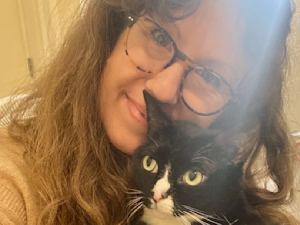
Elizabeth Laura Nelson
Elizabeth Laura Nelson is a writer and editor based in Brooklyn, New York, whose work has appeared in The New York Times, Jenny, Best Life, YourTango, Elite Daily, and more. Topics of interest include relationships, health and wellness, midlife, and lifestyle. As a child, Elizabeth was scared of cats (claws and teeth, yikes) but she has since gotten over her fear and now shares her home with three sweet and gentle feline companions who make life better (and cuddlier) every day.
Related articles
![woman draped in an orange blanket holds a black-and-white puppy]()
Puppy Developmental Stages and Milestones
What to Expect When You’re Expecting – canine edition
![White and brown puppy destroyed a stuffed toy]()
5 Ways to Stop Your Puppy From Ripping Up Their Toys
How to teach your dog to enjoy, not destroy, their toys
![Golden retriever puppy upside down playing with a mans hands and attempting to play bite.]()
How to Stop Puppy Biting: Training Your Puppy
Because bite marks are not a good look
![Man walking his dog in the city]()
What Is the BAT Dog Training Method?
Behaviour Adjustment Training (BAT) will keep your dog calm in any situation
![Female dog trainer raising a treat above a beagle dog's head]()
Your Dog’s Trauma Triggers Are Everywhere. Fear Free Training Can Help
The founder of Fear Free Pets, Dr Marty Becker, on how this method makes vet visits, training sessions and grooming appointments less stressful for pets

